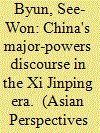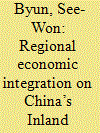|
|
|
Sort Order |
|
|
|
Items / Page
|
|
|
|
|
|
|
| Srl | Item |
| 1 |
ID:
104767


|
|
|
|
|
| Publication |
2011.
|
| Summary/Abstract |
Divergent responses to the sinking of the ROKS Cheonan and the shelling of Yeonpyeong Island in 2010 have raised tensions in Northeast Asia. China's enabling response appeared to write North Korea a blank cheque for further provocations; but Beijing has in fact been constrained by fear of destabilisation of the Kim regime. The incidents have prompted a reappraisal of bilateral relations within the region - in particular, the South Korea-US alliance - and revealed the continuing importance of the Sino-US relationship in Korean peninsular security affairs.
|
|
|
|
|
|
|
|
|
|
|
|
|
|
|
|
| 2 |
ID:
147341


|
|
|
|
|
| Summary/Abstract |
Xi Jinping took office in 2013 with a vision for a “new type of major-power relations” between China and the United States. What does this concept mean and why is it important now? An examination of the current Chinese discourse on major-power relations, as reflected in official and scholarly writings, reveals more continuity than change in China's external orientation. China's major-powers model reinforces (1) peaceful intentions rather than hegemonic aspirations, (2) the primacy of advancing China's domestic development rather than its international position, and (3) tensions between China's dual identities as a rising power and developing economy. The most distinct feature of this model is that it remains a Chinese proposition, posing a question as to the extent to which the United States and China are aligned in perceptions of their future relationship and the international order more broadly.
|
|
|
|
|
|
|
|
|
|
|
|
|
|
|
|
| 3 |
ID:
179273


|
|
|
|
|
| Summary/Abstract |
Research on the relationship between international economic and political relations has produced no consensus on the pacifying effects of trade. Rapid trade growth and enduring tensions characterize post–Cold War Asia’s paradox. This study assesses the political effects of China-centered interdependence based on the China–South Korea case since 1992. Although trade may inhibit conflict in line with liberal expectations, its coercive potential limits its pacifying effects. When disputes arise, asymmetric interdependence generates strategic leverage and vulnerability, and amplifies the identity dimensions of conflict that shape societal preferences. China’s combination of economic pressure and nationalist discourse induces accommodation primarily through coercion. By blending state-led and society-led retaliation, economic and accountability costs are minimized. China–South Korea political interactions have increased in quantity but not quality. The Asian case underscores qualitative changes in political relations (rather than just instances of conflict), the material and nonmaterial repercussions of asymmetric trade, and the regional security implications of China-led interdependence.
|
|
|
|
|
|
|
|
|
|
|
|
|
|
|
|
| 4 |
ID:
193636


|
|
|
|
|
| Summary/Abstract |
How do China and South Korea see their relationship after 30 years of normalization, and why have views shifted since 2017? Research on perceptions and their foreign policy implications usually draws from official discourse and public opinion. This review essay assesses the nature and drivers of China-South Korea mutual perceptions by comparing their academic literature on bilateral relations. Scholarly accounts may offer longer-term interpretations of specialized interests, and a fuller picture of how and why views vary. On both sides of the China-South Korea academic debate, the quantitative volume of studies and qualitative appraisal of relations declined in the 2017–2021 Xi Jinping-Moon Jae-in period. Levels of optimism/pessimism vary by issue-area. Views of third-party constraints on security relations, and domestic political influences on societal relations, drive mutual pessimism. Koreans are more pessimistic about the economic partnership and reassess historical relations more unfavourably, which trace back to views of relative dependence and hierarchy. Three implications emerge for post-2022 relations in light of leadership transition in Beijing and Seoul. Enduring security priorities require minimum strategic interdependence and stronger trust-building mechanisms. Positive functional spillovers from economic and local/nonstate cooperation remain in question. And lasting cultural costs of political disputes compel joint efforts to enhance mutual understanding. Overall, shifts in structural and ideational factors that historically drove normalization are driving the current discord, and prompting both sides to lower future expectations of each other.
|
|
|
|
|
|
|
|
|
|
|
|
|
|
|
|
| 5 |
ID:
189255


|
|
|
|
|
| Summary/Abstract |
Why has China’s economic integration with Asia lagged in the northeast despite high expectations since the 1990s? China-centered integration in Asia is best understood at the Chinese subnational level. The interaction of central, local, and international interests under given structural and historical conditions produces distinct provincial trajectories of foreign economic engagement. While central state interests dictate policy choice under authoritarian rule, policy outcomes are shaped through local feedback effects and institutional innovations to manage transnational exchange. The Jilin-Northeast Asia case over the past two decades shows a negative orientation of such dynamics, stemming from a poor alignment of interests, the region’s structural constraints, and a socialist historical legacy. By tracing change and continuity on China’s late-developing, inland periphery, this study points to the subnational dimensions of cross-border integration obscured by conventional international relations scholarship, and presents the other side of China’s coastal success story. China’s ongoing plans for Asian integration are linked to the long-term development of China’s own regions rather than just aspirations abroad.
|
|
|
|
|
|
|
|
|
|
|
|
|
|
|
|
|
|
|
|
|